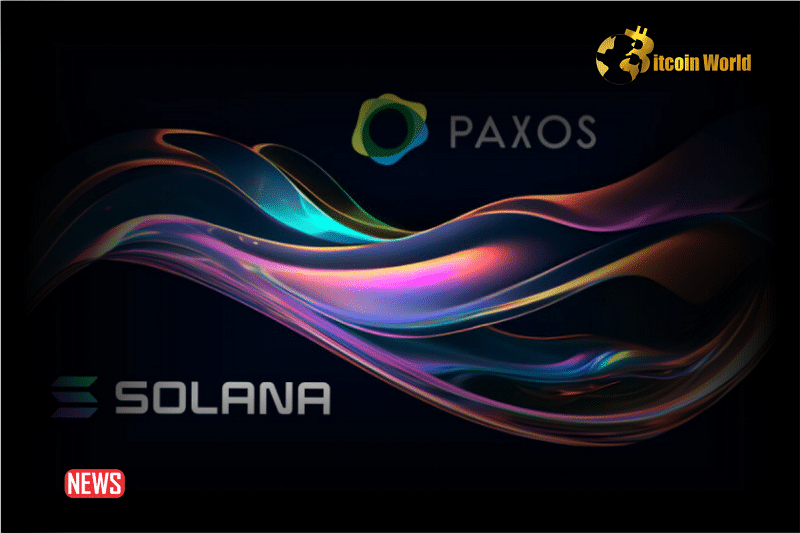Remember when Paxos, a major stablecoin issuer, had to sunset BUSD amidst increased regulatory scrutiny? It was a tough blow, signaling a tightening grip on the crypto world. But like a phoenix from the ashes, Paxos is making a strategic comeback! This time, they’re not just back, they’re expanding their reach by bringing their US Dollar-backed stablecoin, USDP, to the Solana blockchain. Let’s dive into what this means for you, the crypto enthusiast, and the future of stablecoins.
Paxos USDP Finds a New Home: Why Solana?
After navigating the choppy waters of regulatory pressure that led to the BUSD shutdown, Paxos has secured a significant win. They’ve received the green light from the New York Department of Financial Services (NYDFS) – a regulatory body known for its stringent standards – to launch USDP on Solana. This isn’t just any expansion; it’s a strategic move that could reshape the stablecoin landscape.
- From Setback to Comeback: Paxos demonstrates resilience and commitment to regulatory compliance after the BUSD challenges.
- NYDFS Approval: Securing approval from NYDFS underscores Paxos’ dedication to operating within a regulated framework, adding a layer of trust and security to USDP.
- Solana Network Expansion: USDP, previously primarily on Ethereum, is now set to leverage Solana’s blockchain for faster and cheaper transactions.
See Also: Binance To End Support For BUSD Stablecoin In December
Why Solana? Speed and Efficiency Take Center Stage
Paxos officially announced on Friday that the NYDFS has given the go-ahead to extend USDP to Solana, moving beyond its initial Ethereum base. This expansion is slated to go live on January 17, 2024. But why choose Solana? The answer lies in its technological prowess.
Solana is renowned for its:
- Blazing-Fast Transactions: Capable of handling up to 60,000 transactions per second (TPS), Solana leaves many other blockchains in the dust when it comes to speed.
- Low Transaction Fees: Solana boasts significantly lower transaction costs compared to Ethereum, making it more accessible and economical for everyday users and high-volume applications.
These features make Solana an ideal platform for stablecoins like USDP, which are designed for frequent and cost-effective transactions. Imagine using USDP for everyday payments, DeFi activities, or even high-frequency trading – Solana’s infrastructure makes it all smoother and more affordable.
Paxos: Setting a New Standard for Stablecoins?
In their official statement, Paxos highlighted Solana’s technical advantages as the driving force behind this expansion. Walter Hessert, Head of Strategy at Paxos, emphasized the strategic rationale:
“The expansion of our stablecoin platform to support Solana marks an important step towards making stablecoins ubiquitous for everyday consumers. Paxos has set the standard for oversight, reserve management and issuance in the stablecoin market. By integrating USDP with Solana, we’re making it easier for anyone to get and use the safest, most reliable stablecoins.”
Paxos is positioning itself as a leader in regulated stablecoins. Hessert even points out that Paxos is the only stablecoin issuer regulated by the NYDFS globally. This is a significant claim, suggesting that neither Tether (USDT) nor Circle (USDC), the two giants in the stablecoin arena, hold the same level of regulatory approval from this specific, highly regarded body.
The Regulatory Edge: Why NYDFS Approval Matters
Why is NYDFS approval such a big deal? Well, getting a license to issue stablecoins in New York is known to be incredibly difficult. The NYDFS is recognized for its rigorous regulatory framework and high standards. This stringent process implies that stablecoins approved by NYDFS, like USDP, undergo intense scrutiny and must adhere to strict operational and reserve requirements.
This regulatory endorsement could give USDP a competitive edge. In a market increasingly sensitive to regulatory compliance, Paxos’ NYDFS approval can instill greater confidence in users and institutions seeking a secure and trustworthy stablecoin option.
What Does This Mean for the Stablecoin Market and Solana?
Paxos bringing USDP to Solana is more than just a platform expansion; it has wider implications:
- Increased Competition: A regulated and efficient stablecoin like USDP on Solana can introduce healthy competition in the stablecoin market, potentially challenging the dominance of USDT and USDC, especially within the Solana ecosystem.
- Growth for Solana Ecosystem: Having USDP on Solana can attract more users and developers to the network. Stablecoins are crucial for DeFi, trading, and various applications within a blockchain ecosystem. USDP’s availability can fuel further growth and adoption of Solana.
- Mainstream Adoption of Stablecoins: By focusing on regulatory compliance and leveraging efficient blockchains like Solana, Paxos is contributing to the broader acceptance and utility of stablecoins for everyday use.
Looking Ahead: USDP on Solana and the Future of Stablecoins
Paxos’ expansion of USDP to Solana marks a significant step forward for both the company and the stablecoin industry. By navigating regulatory challenges and embracing technological advancements, Paxos is positioning USDP as a reliable and efficient stablecoin for the future. As the crypto landscape continues to evolve, the combination of regulatory compliance and blockchain innovation, as exemplified by Paxos and Solana, may well be the key to unlocking the full potential of stablecoins and their integration into the mainstream financial system.
Will USDP on Solana become a major player? Only time will tell, but the stage is set for an interesting chapter in the stablecoin story. Keep an eye on January 17, 2024 – that’s when USDP officially arrives on Solana!
Disclaimer: The information provided is not trading advice, Bitcoinworld.co.in holds no liability for any investments made based on the information provided on this page. We strongly recommend independent research and/or consultation with a qualified professional before making any investment decisions.


